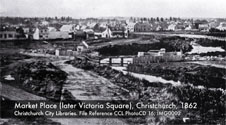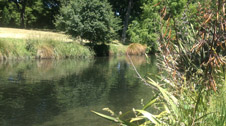Ngāi Tūāhuriri were a thriving people in 1848. The social structures of Iwi, hapu and whanau worked alongside the practices of mahinga kai (food gathering places) to keep everyone fed and healthy. Ōtākaro was a primary mahinga kai for Ngāi Tūāhuriri. This slow-moving body of fresh water was a major driver for the economy, providing their people with food to keep bellies full, as well as for trade with the settlers in the Christchurch region.
 If time permits, you may wish to follow the winding course of Ōtākaro Eastward, and you will be brought to Victoria Square. This was a site of plentiful trade between Māori and European settlers, known in 1848 as Market Square.
If time permits, you may wish to follow the winding course of Ōtākaro Eastward, and you will be brought to Victoria Square. This was a site of plentiful trade between Māori and European settlers, known in 1848 as Market Square.
Visualise people visiting Ōtākaro in the summer months to spear flounder, and catch eels, whitebait and trout. Picture the portions set aside laid out to dry to be preserved for the harsh winter to follow. Hear the laughter of children as they play on the banks while their parents work. Today, you may see people punting on the river, enjoying the peace the river can provide in the central city, or perhaps you hear the laughter of children as they chase each other in kayaks, reminiscent of the Ngāi Tūāhuriri children playing in 1848.
Ōtākaro was lost as a mahinga kai through the Kemp Purchase due to the deliberate misinterpretation of the phrase as not “food gathering sites”, but “cultivations” or “plantations”. This significantly restricted the rights of Ngāi Tūāhuriri to utilise this resource, and consequently had a severe negative impact on personal health, as well as their ability to trade.
Following the earthquakes in Christchurch, Ōtākaro (the Avon River), along with other waterways in Christchurch and Canterbury, became contaminated. This restricted the activities that could be enjoyed on the river or other Christchurch beaches, and caused a decline in the numbers of Inanga (whitebait) and other species of fish which once swam in relative abundance through the waters of Ōtākaro.
 While people no longer rely on Ōtākaro for sustenance, it was still felt as a significant loss to the city to have the river so affected. It was yet another effect of an event which took so much from the people of Christchurch. The CDHB and Medical Officer of Health had the power to determine what activities, such as leisure and food gathering, could occur on and in Christchurch waterways. The loss of the leisure activities the waterways provided was felt particularly keenly, and the economy of central Christchurch ground to a halt.
While people no longer rely on Ōtākaro for sustenance, it was still felt as a significant loss to the city to have the river so affected. It was yet another effect of an event which took so much from the people of Christchurch. The CDHB and Medical Officer of Health had the power to determine what activities, such as leisure and food gathering, could occur on and in Christchurch waterways. The loss of the leisure activities the waterways provided was felt particularly keenly, and the economy of central Christchurch ground to a halt.
Ngāi Tahu and Ngāi Tūāhuriri have spent over a century and a half fighting for their rights, and are now a thriving part of the Christchurch and wider Canterbury region economy. They are investing resources into young Māori to create strong, well-educated leaders, and Ngāi Tahu are leading the way in ecosystem and mahinga kai preservation in the post-earthquake environment.